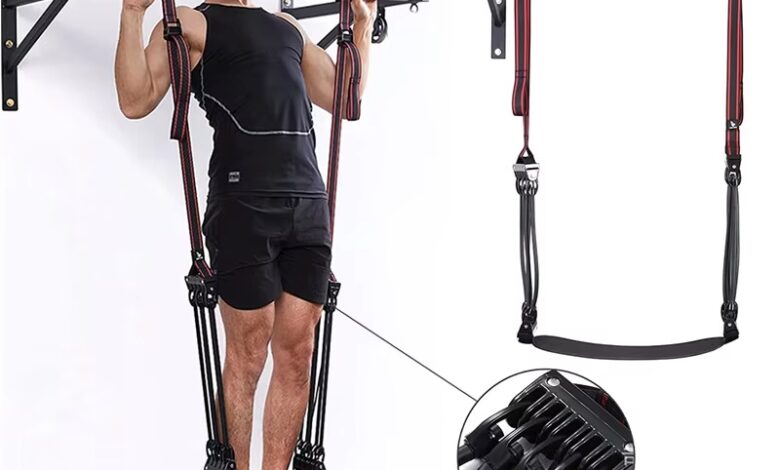How Pull-Up Assistance Bands Help Speed Up Your Pull-Up Progress

Pull-up assistance bands have revolutionized the way fitness enthusiasts approach one of the most challenging bodyweight exercises. These simple yet effective tools provide a progressive pathway to achieving unassisted pull-ups while maintaining proper form and building the necessary strength foundations.
Understanding Pull-Up Assistance Bands
Pull-up assistance bands, also known as resistance bands for pull-ups, are large, thick rubber loops specifically designed to aid in performing pull-ups. These bands come in various resistance levels, typically ranging from 5 to 175 pounds of assistance, to accommodate users of different strength levels.
When anchored to a pull-up bar and stretched to support the user’s body weight, the bands generate an upward force that effectively reduces the amount of weight the user needs to lift during the exercise. The science behind pull-up assistance bands lies in their elastic properties: as the band stretches, it stores potential energy, which is then released as kinetic energy, helping propel the user upward during the concentric phase of the pull-up.
This assistance is most significant at the bottom of the movement—where individuals often struggle the most—and gradually decreases as the user pulls higher. This creates a natural progression in difficulty throughout the pull-up’s range of motion, making these bands an effective tool for building strength and improving pull-up performance.
Physiological Benefits of Band-Assisted Pull-Ups
Research conducted at the University of Wisconsin-La Crosse has shown that band-assisted pull-ups maintain similar muscle activation patterns to traditional pull-ups. The primary muscles engaged include:
The latissimus dorsi muscles, which serve as the main pulling muscles during the exercise, experience significant activation even with band assistance. The rhomboids and trapezius muscles work in coordination to stabilize the shoulder blades throughout the movement. The biceps brachii and brachialis contribute substantially to elbow flexion during the upward phase.
When performing band-assisted pull-ups, the nervous system develops crucial motor patterns. The consistent practice of the full range of motion with proper form allows the brain to create strong neural pathways, improving movement efficiency and muscle recruitment patterns. This neural adaptation is essential for developing the strength and coordination needed for unassisted pull-ups.
Progressive Development Strategy
The journey begins with selecting the appropriate band resistance. A proper starting point allows users to perform 8-12 repetitions with good form. This typically requires enough assistance to reduce the effective body weight to a manageable level while still providing sufficient challenge for strength development.
The initial phase focuses on developing the fundamental strength and movement patterns. Users should aim to perform 3-4 sets of 8-12 repetitions, maintaining strict form throughout each set. This phase typically lasts 4-6 weeks, during which the body adapts to the new movement pattern and begins building the necessary muscle tissue.
As strength improves, users can implement a systematic approach to reducing assistance. This process typically follows a pattern:
Start with a heavy-resistance band that provides substantial support. Once able to perform multiple sets of 12 repetitions with perfect form, transition to a lighter band. Gradually decrease band assistance while maintaining proper repetition ranges and form quality. Eventually, incorporate partial sets with no band assistance.
Technical Aspects of Band-Assisted Pull-Ups
The correct implementation of band assistance requires attention to technical details. The band should be securely anchored to the pull-up bar, creating a stable loop. Users should place either one knee or foot in the band, ensuring it remains centered throughout the movement.
The starting position requires full arm extension with engaged shoulder blades. Throughout the movement, maintain a neutral spine position and avoid swinging or using momentum. The pull-up motion should be controlled and deliberate, focusing on engaging the back muscles rather than relying solely on arm strength.
Proper breathing technique enhances performance and stability during band-assisted pull-ups. Users should exhale during the concentric (pulling up) phase and inhale during the eccentric (lowering) phase. This breathing pattern helps maintain core stability and ensures optimal oxygen delivery to working muscles.
Recovery and Progress Monitoring
Optimal progress requires balanced training frequency. Most users find success with performing band-assisted pull-ups 2-3 times per week, allowing 48-72 hours between sessions for proper recovery. This frequency provides adequate stimulus for strength development while preventing overtraining.
Monitoring progress helps maintain motivation and ensures consistent advancement. Users should maintain a training log documenting:
- Band resistance used
- Number of sets and repetitions completed
- Quality of form during each set
- Recovery time needed between training sessions
- Overall energy levels and performance
Long-term Progression Strategies
Implementing structured periodization helps prevent plateaus and ensures continuous progress. A basic periodization model might include:
- Volume-focused phases emphasizing higher repetitions with greater band assistance. Strength-focused phases utilizing lower repetitions with reduced assistance. Power phases incorporating explosive variations while maintaining proper form and control.
- Supporting exercises enhance overall pull-up development. These include scapular pull-ups, inverted rows, and targeted back strengthening movements. These complementary exercises help address potential weaknesses and ensure balanced muscle development.
Conclusion
Pull-up assistance bands provide a scientifically sound approach to developing pull-up strength. By following a structured progression strategy and maintaining attention to technical details, users can effectively build the strength and skill necessary for unassisted pull-ups. The key lies in consistent practice, proper form, and patient progression through assistance levels.





